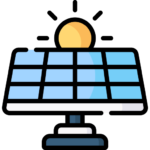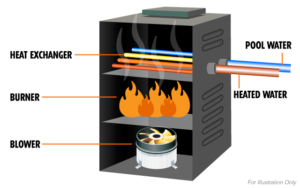How To Heat Your Pool

POOL AND SPA HEATING OPTIONS
An inviting pool or spa may look great, but the ideal water temperature must be set to a level where the experience meets expectation. Therefore a heating system is required, but which one? As there are many options in heating a swimming pool or spa it is advisable to contact a pool heating specialist and have a heat load evaluation to find the most practical, cost effective and environmentally friendly system that is best suited. The most commonly available options that are currently used are:

SOLAR
Solar is an extremely economical and effective way of heating a pool and has a relatively low capital cost. Water is pumped from the pool to a heat collector fitted to the roof that absorbs the radiant energy from the sun and returns to the pool. This heat collector can be made in many different styles; some are made from extruded PVC Nitrile or EPDM rubber into strip, moulded tube panels, glazed poly panels and more. There is a long life expectancy for most solar systems as they are made from high tech plastics, maintenance is negligible as there is minimal moving parts and solar is generally easily installed, all of which makes this a great option to help heat a pool. Solar takes full advantage of the suns free heat which is the most environmentally friendly and economical way to heat a pool, while avoiding rising energy costs over the warmer swimming season.

HEAT PUMP
Heat Pumps have become more common for heating as capital costs have been reduced and can be used as a stand-alone system as long as heat load calculations have been performed correctly. Heat pumps work like a reversed air conditioner. Instead of taking air from a room or building, removing the heat and returning it, a heat pump takes large quantities of air from the atmosphere, removing the heat contained in the air and transferring this to water from the pool or spa passing through the unit. The characteristic of the heat pump of absorbing heat value from air means that the unit has a low electrical input relative to its heat transfer. A well designed heat pump will output heat at a rate of around 5:1 or even higher, relative to its energy input under summer conditions. This greatly reduces total energy consumption. This factor is called the heat pump's co-efficient of performance or COP. The capture of solar energy from air means that the heat pump's output and efficiency will vary with air temperature. Higher efficiency is gained in more temperate locations but heat pumps are capable of maintaining pool temperatures year-round in nearly all areas of Australia and New Zealand.

GAS HEATER
Gas heating has traditionally been the most common form of pool heating as it is easy to install, has a low capital outlay and can provide rapid heat up times. They work by pool water being pumped through a heat exchanger that sits near a gas fired burner or pool water is pumped through a water to water heat exchanger which is heated by a gas fired boiler in a closed loop. The water to water heat exchanger method can be a more robust system as the chemically treated pool water is kept away from the heater. Gas heaters utilise fan assistance that aids in the combustion and heat transfer process that increases efficiencies and reduces operating costs. A gas heater is an ideal standalone system when natural gas is available or the perfect back up for Solar or Heat Pump systems.

SMART HEATING CONTROL MEANS MAXIMUM EFFICIENCY
SMART HEATING CONTROL ELECTRONICS MEANS MAXIMUM EFFICIENCY Even the most economical heating systems for pools and spas can require a backup system and this is where a digital control system can pay dividends. The controller will monitor temperatures and use the most practical and economical way of heating, switching between heat sources as required. When Solar Systems are used the controller will monitor the pool temperature and when heating is required will turn the solar system on if there is enough solar gain. If fitted with a gas heater or a heat pump in conjunction with solar - the controller will determine which heat source is best to use. If heating is required the controller will check solar temperature and if insufficient, it will switch on the auxiliary heater and will run until the limit is achieved or until there is sufficient solar gain. If solar gain is insufficient for the water temperature to reach the limit, then both heat sources will run concurrently.

HOW TO SAVE ON RUNNING COSTS AND THE ENVIRONMENT
When multiple heat sources are utilised, it is imperative to set the most economical heat source to a higher temperature setting than the other. Consequently, the cheaper heat source will push the water temperature above the minimum limit so the extra energy is stored in the pool water which minimises the backup heaters run time. The greater the temperature difference between the two settings the larger the savings will be. What needs to be considered are the minimum and maximum temperature settings that are comfortable for swimmers. Commonly used minimum and maximum temperatures are 27 degrees Celsius and 30 degrees Celsius respectively, however, this will differ from state to state as pool temperature needs to be set relevant to ambient air temperature to achieve a comfortable level.
